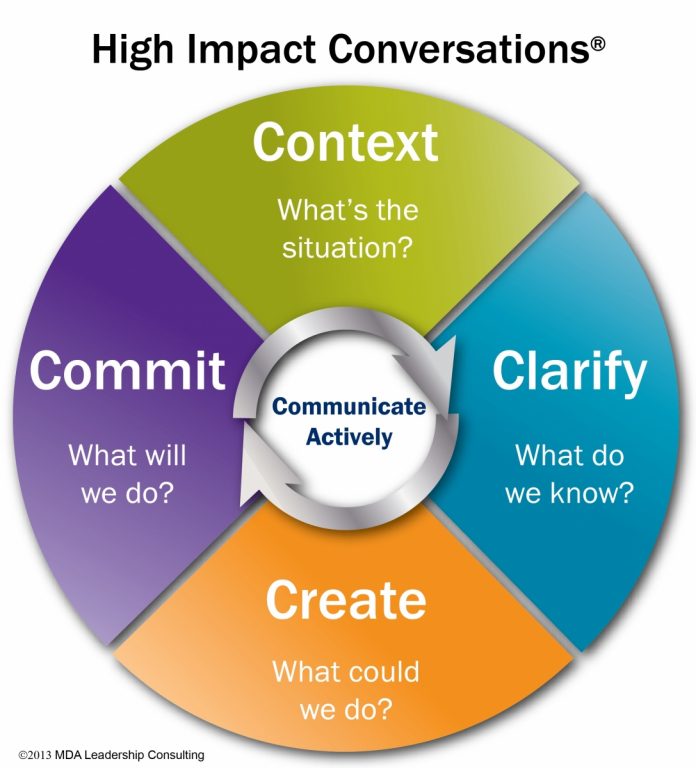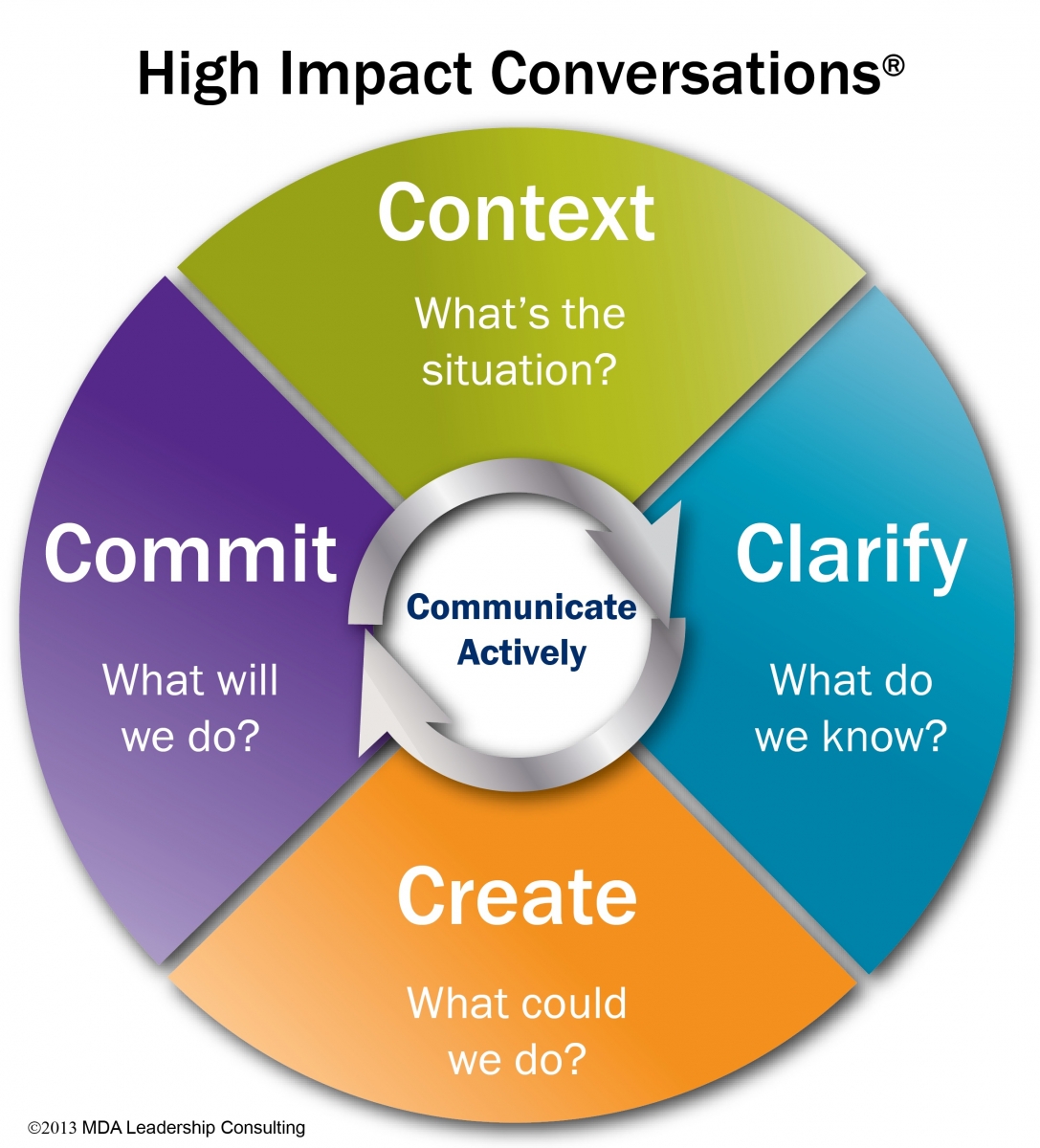
What if every work-related conversation in your organization could drive performance, transfer learning, and build relationships? We believe this can and should happen. Such conversations need to become the norm, not the exception.
Organizations crave more impactful conversations, more of the time. Our clients talk about the time wasted and the outcomes missed because the right conversations did not happen at the right time in the right way. It’s no wonder so many business leaders have trouble effectively communicating with others at work. Of all the attributes of newly minted MBA graduates, Fortune 100 employers most value oral communication skills, according to the 2014 Corporate Recruiters Survey. In fact, on average, employers ranked communication skills twice as important as managerial skills for new hires.
Yet compare these findings with the typical core curriculum of MBA programs, which includes classes in accounting, business strategy, economics, finance, marketing, and technology, but usually no courses in interpersonal communications. Instead, most MBA programs simply assume their students will become quality interpersonal communicators.
Many leaders make similar assumptions about themselves—that if they’ve earned the right degrees, landed good jobs, and gained promotions and lofty titles, they must be effective communicators. In reality, based on our combined 50-plus years of work with thousands of leaders of all types and ranks, we’ve found minimal correlation between the intelligence, credentials, or roles of leaders and their communication effectiveness.
It doesn’t have to be this way. Most leaders can rapidly and significantly become better communicators. It’s often not so much by saying the right combination of words, but rather by conveying these words in ways that achieve maximum impact and effectiveness. It’s a learned technique we call “High Impact Conversations.”
WHAT IS A HIGH IMPACT CONVERSATION?
A High Impact Conversation is one that gets someone to commit to action. Unlike workplace chatter or “water cooler talk,” High Impact Conversations are specific, deliberate conversations meant to foster greater workplace alignment and shared accountability. Leaders who regularly and effectively engage in High Impact Conversations typically enjoy greater commitment from their employees and a superior ability to achieve results through others. There are four sequential “C” components to a High Impact Conversation:
- Context What’s the situation?
- Clarify What do we know?
- Create What could we do?
- Commit What will we do?

Let’s illustrate what we mean, based on a fictional example:
Michael, a manager with ABC Office Supply, comes to his boss, Jennifer, with a problem: ABC’s shipment of widgets to a key customer is going to be late.
Without the High Impact Conversation framework, Jennifer’s immediate response to Michael’s news might focus on the reasons for the delay: “What? Why? I thought production was up to speed. What’s going on?”
Or she might “shoot the messenger”: “What do you mean we’re going to be late? What are you doing to fix this?” Unfortunately, these responses likely will not help Jennifer build a productive, long-term relationship with Michael.
Instead, here’s how a High Impact Conversation could work for Jennifer and Michael:
Context: What’s the situation?
Jennifer should begin by first asking Michael more about the situation to create better mutual understanding of the problem at hand. Some sample questions and statements for this first stage:
- What’s your take on this situation?
- What new information have you gathered?
- I believe we need to address this part of the problem first.
- I suggest thinking about x first.
Clarify: What do we know?
Next, Jennifer should clarify and confirm the information at hand. This creates better shared understanding of the topic. Sample clarifying questions and statements include:
- That’s an interesting conclusion; arrive at it?
- You say x is happening; how do you know this?
- Based on your input, here is what I see and what I think is happening. Is this correct?
Create: What could we do?
After Jennifer and Michael discuss the situation and the information known about it, they can discuss next steps or solutions. Some sample questions and statements:
- What options do you see?
- If this were to go the way you want, what would that be?
- Here are couple of ideas and why I believe they can work.
- I’d like you to try x, and here is why.
- I was in a similar situation; here is what I did and why I believe it applies here.
Commit: What will we do?
Lastly, after discussing the solution or next steps to be taken, Jennifer and Michael can determine desired timing and feedback. Sample commitment questions and statements here include:
- What is your decision?
- How are you planning to handle this?
- I suggest that you do x before y.
- Here is what I can do to support you.
Note that you cannot have a High Impact Conversation on “autopilot” or by skipping steps. Each of the four components must be proactively addressed in sequential order.
APPLYING HIGH IMPACT CONVERSATIONS
Workplace conversations typically have at least one (and sometimes all three) of the following goals:
- Transfer learning: Learn more about each other’s points of view, interests, concerns, and goals.
- Drive performance: Create better clarity about roles, expectations, and the overarching goals of your organization and team.
- Build relationships: Strengthen your work relationship based on gaining clarity about the work and greater understanding of each other.
A High Impact Conversation helps address all of these goals. It’s ideal for some of the most important types of conversations you’ll have in the workplace:
- Solving complex issues: Promoting productive exchanges of relevant information and ideas and gaining commitments to act.
- Resolving conflict: Solving problems and preserving relationships.
- Inspiring others: Engaging others in your vision.
- Gaining alignment: Aligning team members and even entire organizations.
- Delivering individual feedback: Providing purposeful, effective feedback.
- Accelerating performance: Enhancing performance based on regular conversations filled with knowledge, insights, and lessons learned.
- Developing talent: Integrating developmentrelated conversations into your dialogue.
The need is clear. Studies show that leaders spend 70 to 90 percent of their daily time in conversation, yet much of the potential power of these conversations is wasted, as leaders do not intentionally use this time to achieve optimal outcomes. A High Impact Conversation can make the difference between average and great workplace performance.
Kevin Louiselle, Ph.D., is senior vice president and partner of MDA Leadership Consulting. He has more than 30 years of experience helping organizations align talent management and leadership development solutions with business objectives. His Ph.D. is in industrial/organizational psychology.
Scott E. Nelson is CEO of MDA Leadership Consulting. He has more than 25 years of experience helping organizations achieve their desired state through systemic, sustainable talent development at the individual, team, and enterprise level. He is the principal architect behind MDA’s signature “Awaken, Align, Accelerate” framework for leadership development.


